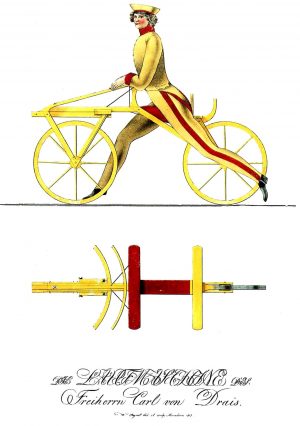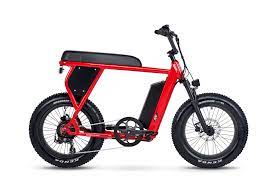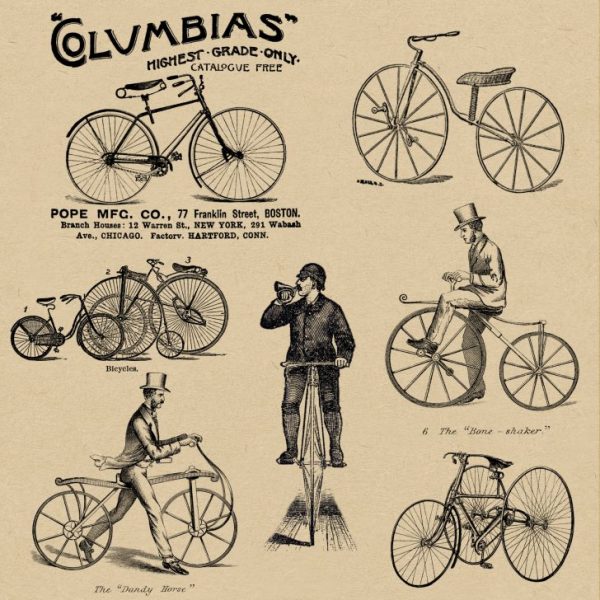The basic mechanics of the bike are pretty simple — it’s basically a triangle with wheels and a chain drive to propel it forward. No batteries or engines. It seems obvious in hindsight …. And that’s why most people guess the bike was invented a long time ago. Yet the ‘running machine,’ a kind of early proto-bike, debuted around 1817.
 In the wake of the running machine, powered by feet actually running along the ground (with a saddle straddling above) came the “boneshaker,” which added wheels but still featured stiff tires, hence the rough ride. At first, bicycles like these were mainly seen as novelties, or the playthings of daredevils who accepted their dangers.
In the wake of the running machine, powered by feet actually running along the ground (with a saddle straddling above) came the “boneshaker,” which added wheels but still featured stiff tires, hence the rough ride. At first, bicycles like these were mainly seen as novelties, or the playthings of daredevils who accepted their dangers.
Early bicycles shared a common problem: each turn of the pedal corresponded to a turn of the wheel — there was no shifting of gears. So to get farther faster, styles like the “penny farthing” were invented with huge front wheels allowing increased speeds. Unfortunately, these were difficult to balance on and involved in a lot of accidents.
The introduction of a chain drive allowed pedals to move away from wheels and also decoupled the one-to-one turn issue that had led to large imbalances in wheel sizes. Coupled with a stable diamond-shaped frame, this innovation made bikes safer and spurred their adoption.
 Now, a century or so later, e-bikes are becoming increasingly popular, marrying the simplicity and efficiency of a bicycle while allowing more people than ever to hop on board with an electric assist. For much more on the history of the bicycle, check out Jody Rosen’s book: Two Wheels Good: The History and Mystery of the Bicycle.
Now, a century or so later, e-bikes are becoming increasingly popular, marrying the simplicity and efficiency of a bicycle while allowing more people than ever to hop on board with an electric assist. For much more on the history of the bicycle, check out Jody Rosen’s book: Two Wheels Good: The History and Mystery of the Bicycle.




Comments (2)
Share
I’m not too surprised that bikes only took off in the late 1800s.
Bikes require the following:
1. A hard, flat surface: cycling with a hard wheel on a mucky surface doesn’t you very far very fast. Tarmacadam’d roads haven’t been around for very long. Many places do have hard, dry roads for most of the year.
2. Suspension: Until the invention of rubber, wheels were hard and this meant that all vibrations were sent up the body. Boneshakers were called that for a reason. Old Roman roads were paved and city roads were cobbled. Cycling on these roads is not fun.
3. Reason to use one: Until the Industrial Revolution, most people lived in the countryside. Nobles had horses & carriages. Peasants were stuck to the land. If they went anywhere, they walked or took a carriage, if one was available. They would have been useful for the person who had to walk a day to the town or city to visit a friend/doctor/lawyer. Again, the roads were usually made of mud and one did not arrive in a state fit for polite company. Added to that, people didn’t always travel alone. Women usually had children in tow. Farmers had carts with produce or tools in them. It might have been a good tool for the single man who needed to visit people professionally but didn’t necessarily have a horse, like the local priest, doctor or vet.
What is somewhat surprising is that they were never invented by an enterprising officer in an army. Maybe the roads were too poor. The ability for the infantry to be able to travel astonishingly quickly (by the standards of the day) could well have made a difference in a war. Fewer supplies would be needed to feed men if they spent fewer days on the road and replacements could be sent faster to the battlefield.
A second comment:
We’ve had eBikes for the last decade in Switzerland and they suit some classes of people very well.
They are especially useful to the elderly. It replaces their loss of strength by means of the battery-powered pedal-assist.
They are more useful in the countryside than ordinary bikes, especially when the terrain is very hilly. One can cover greater distances with ease with eBikes in comparison to walking or cycling. They are popular here for tourism. The Emmental region has them on offer, for example.
In cities they are useful because they are easy to park. They are quite quick and quicker than cars in the city when there are dedicated cycle-lanes.
In urban & suburban areas, they are practical when combined with bike trailers. These can carry up to 40Kg, such as one or two small children or their backpacks. I go shopping with ours every Friday evening. i don’t have to worry about parking or hills. Partly because of the bike trailer, the e-bike and an ordinary bike (as well as car-sharing schemes and good public transport), we get by quite nicely without a car.
There are a couple of disadvantages to them though: they are expensive and they don’t last all that long. You might get 10 years out of them, if you are lucky. They are also heavy, which can be a pain in the arse if your battery loses charge.